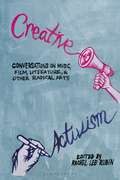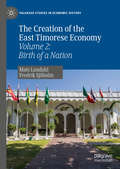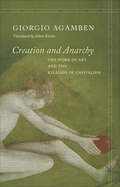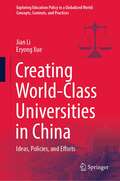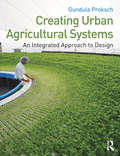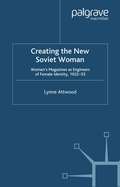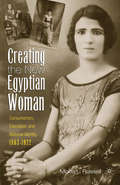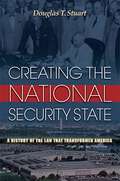- Table View
- List View
The creative citizen unbound: How social media and DIY culture contribute to democracy, communities and the creative economy (Connected Communities)
by Ian Hargreaves John HartleyThe creative citizen unbound introduces the concept of ‘creative citizenship’ to explore the potential of civic-minded creative individuals in the era of social media and in the context of an expanding creative economy. Drawing on the findings of a 30-month study of communities supported by the UK research funding councils, multidisciplinary contributors examine the value and nature of creative citizenship, not only in terms of its contribution to civic life and social capital but also to more contested notions of value, both economic and cultural. This original book will be beneficial to researchers and students across a range of disciplines including media and communication, political science, economics, planning and economic geography, and the creative and performing arts.
Creative Approaches to Planning and Local Development: Insights from Small and Medium-Sized Towns in Europe
by Christophe Demaziere Abdelillah Hamdouch Torill Nyseth Anniken Førde José Serrano Nils AarsætherThis book project highlights creative approaches to planning and local development. The dynamic complexity, diversity and fluidity which characterize contemporary society represent challenges for planning and development endeavours. While research and policy work has extensively focused on large cities and on metropolitan regions, there has been relatively little work on ‘smaller places’. This book shows that if these new challenges affect all places and regions, small and medium-sized towns (SMSTs) are suffering many specific problems that call imperatively for the design and implementation of very imaginative, creative approaches to planning and local development. What could enhance creativity in local development and planning? Is it possible to talk about creative capacity building at the level of a town that might release imaginative and innovative activities? Under what local and non-local conditions is creativity being initiated and flourishing? What are the major obstacles and in what way can these be contained in order to safeguard pockets of creative action? Interdisciplinary and with case studies from France, Norway and other European countries, this volume presents a wide range of approaches and territorial contexts of small cities and towns in which spatial dynamics and the consequences of the city-region for urban planning theory and practice in Europe are highlighted, with a special focus on the challenges for - and understanding of - planning and development of SMSTs. It provides a significant body of critical, comparative and contextual perspectives on the quest for urban sustainability and resilience in SMSTs, therefore emphasizing collaborative and potentially innovative approaches that can be detected, but also the shortcomings, pitfalls and 'traps' that can lie behind the approaches aimed at concerting ecological, economic, and socio-cultural concerns, and the discourses promoting them.
Creative Approaches to Planning and Local Development: Insights from Small and Medium-Sized Towns in Europe
by Abdelillah Hamdouch Torill Nyseth Anniken Førde José Serrano Nils Aarsæther Christophe DemazièreThis book project highlights creative approaches to planning and local development. The dynamic complexity, diversity and fluidity which characterize contemporary society represent challenges for planning and development endeavours. While research and policy work has extensively focused on large cities and on metropolitan regions, there has been relatively little work on ‘smaller places’. This book shows that if these new challenges affect all places and regions, small and medium-sized towns (SMSTs) are suffering many specific problems that call imperatively for the design and implementation of very imaginative, creative approaches to planning and local development. What could enhance creativity in local development and planning? Is it possible to talk about creative capacity building at the level of a town that might release imaginative and innovative activities? Under what local and non-local conditions is creativity being initiated and flourishing? What are the major obstacles and in what way can these be contained in order to safeguard pockets of creative action? Interdisciplinary and with case studies from France, Norway and other European countries, this volume presents a wide range of approaches and territorial contexts of small cities and towns in which spatial dynamics and the consequences of the city-region for urban planning theory and practice in Europe are highlighted, with a special focus on the challenges for - and understanding of - planning and development of SMSTs. It provides a significant body of critical, comparative and contextual perspectives on the quest for urban sustainability and resilience in SMSTs, therefore emphasizing collaborative and potentially innovative approaches that can be detected, but also the shortcomings, pitfalls and 'traps' that can lie behind the approaches aimed at concerting ecological, economic, and socio-cultural concerns, and the discourses promoting them.
Creative Activism: Conversations on Music, Film, Literature, and Other Radical Arts
by Rachel Lee RubinThis collection brings together interviews with a compelling range of musicians, artists, and activists from around the globe. What does it mean for an artist to be "political†?? Moving away from a narrow idea about politics that is organized around elections, advocacy groups, or concrete manifestos, the subjects of Creative Activism do their work through song, poetry, painting, and other arts. The interviews take us from Oakland to London to Johannesburg and from the Occupy movement to the coal mines of Appalachia to the fantasy worlds created by some of our most fascinating writers of spectacular fiction. Listening to the important "cultural workers†? of our time challenges any idea that some other time was the golden age of political art: Creative Activism gives us a front-row seat to the thrilling artistic activism of our own moment.
Creative Activism: Conversations on Music, Film, Literature, and Other Radical Arts
by Rachel Lee RubinThis collection brings together interviews with a compelling range of musicians, artists, and activists from around the globe. What does it mean for an artist to be “political”? Moving away from a narrow idea about politics that is organized around elections, advocacy groups, or concrete manifestos, the subjects of Creative Activism do their work through song, poetry, painting, and other arts. The interviews take us from Oakland to London to Johannesburg and from the Occupy movement to the coal mines of Appalachia to the fantasy worlds created by some of our most fascinating writers of spectacular fiction. Listening to the important “cultural workers” of our time challenges any idea that some other time was the golden age of political art: Creative Activism gives us a front-row seat to the thrilling artistic activism of our own moment.
The Creation of the Modern Ministry of Finance in Siam, 1885–1910 (Studies in the Economies of East and South-East Asia)
by Ian BrownUsing Thai-language archival material, this book examines a crucial element in the dismantling of the traditional government structure and the installation of a Western-style administration - the creation of a modern Ministry of Finance.
The Creation of the Human Development Approach
by Tadashi HiraiThis book examines the main reasons and challenges for the success of the human development approach both in theory and practice as an alternative to the economic growth model. Unlike the preceding research which has typically been either theoretical/prescriptive or empirical/descriptive, it follows a pragmatic historical and institutional methodology, since human development cannot be understood without considering the complexities added centrally by the formation process in the UNDP. Referring to the capability approach, it also addresses how to best reflect happiness within this paradigm.
The Creation of the Human Development Approach
by Tadashi HiraiThis book examines the main reasons and challenges for the success of the human development approach both in theory and practice as an alternative to the economic growth model. Unlike the preceding research which has typically been either theoretical/prescriptive or empirical/descriptive, it follows a pragmatic historical and institutional methodology, since human development cannot be understood without considering the complexities added centrally by the formation process in the UNDP. Referring to the capability approach, it also addresses how to best reflect happiness within this paradigm.
The Creation of the East Timorese Economy: Volume 1: History of a Colony (Palgrave Studies in Economic History)
by Mats Lundahl Fredrik SjöholmThis two-volume study explores the economy of East Timor, of which very little has been written since the country gained independence in 2002. Currently, no comprehensive account exists of the economic history of the country. The former cannot be properly understood without a knowledge of the historical process that created the present-day situation. This research monograph is the first book to combine a historical analysis of the creation and development of the economy of East Timor from the earliest times to the present, and an analysis of the main contemporary problems facing the East Timorese economy. Volume I considers East Timor from a chronological perspective, as an occupied country up to the point at which Indonesia leave.This book will appeal to scholars and students of economics, political and social science. It will also be of interest to practitioners in these fields as it focuses on down-to-earth problems that need to be solved for the economy to develop.
The Creation of the East Timorese Economy: Volume 2: Birth of a Nation (Palgrave Studies in Economic History)
by Mats Lundahl Fredrik SjöholmVery little has been written on the economy of East Timor since the country’s independence in 2002, and no comprehensive account exists of the economic history of the country. The former cannot be properly understood without a knowledge of the historical process that created the present-day situation. This research monograph is the first book to combine a historical analysis of the creation and development of the economy of East Timor from the earliest times to the present, and an analysis of the main contemporary problems facing the East Timorese economy. Volume II offers a detailed analysis of the economy of East Timor, of politics, fiscal policy and social progress. It pays particular attention to structural problems: employment generation and the lack of a modern sector, the modernization of agriculture and the management of the oil deposits in the Timor Sea. The first volume, available separately, considers East Timor from a chronological perspective, as a Portuguese colony, and a country occupied by Indonesia up to national independence in 2002. This book will appeal to economists, political scientists and social scientists in general as well as practitioners, since it focuses on down-to-earth problems that need to be solved for the economy to develop. The book can also be read by students both at the undergraduate and graduate levels and could be used for case studies in development.
Creation and Anarchy: The Work of Art and the Religion of Capitalism (Meridian: Crossing Aesthetics)
by Giorgio AgambenCreation and the giving of orders are closely entwined in Western culture, where God commands the world into existence and later issues the injunctions known as the Ten Commandments. The arche, or origin, is always also a command, and a beginning is always the first principle that governs and decrees. This is as true for theology, where God not only creates the world but governs and continues to govern through continuous creation, as it is for the philosophical and political tradition according to which beginning and creation, command and will, together form a strategic apparatus without which our society would fall apart. The five essays collected here aim to deactivate this apparatus through a patient archaeological inquiry into the concepts of work, creation, and command. Giorgio Agamben explores every nuance of the arche in search of an an-archic exit strategy. By the book's final chapter, anarchy appears as the secret center of power, brought to light so as to make possible a philosophical thought that might overthrow both the principle and its command.
Creating World-Class Universities in China: Ideas, Policies, and Efforts (Exploring Education Policy in a Globalized World: Concepts, Contexts, and Practices)
by Jian Li Eryong XueThis book explores how can we shape “World-class University” in China from the perspectives of ideas, policies and efforts, specifically. It examines the essence and logic of creating world-class universities and disciplines and focuses on the construction of a number of universities and disciplines across a number of historical periods. The book also investigates the improvement of China's education, and the higher education needs to “face modernization, face the world, face the future”. It offers a broader vision to connect with the Chinese higher education system and the international higher education communities contextually.
Creating Urban Agricultural Systems: An Integrated Approach to Design
by Gundula ProkschCreating Urban Agriculture Systems provides you with background, expertise, and inspiration for designing with urban agriculture. It shows you how to grow food in buildings and cities, operate growing systems, and integrate them with natural cycles and existing infrastructures. It teaches you the essential environmental inputs and operational strategies of urban farms, and inspires community and design tools for innovative operations and sustainable urban environments that produce fresh, local food. Over 70 projects and 16 in-depth case studies of productive, integrated systems, located in North America, Europe, and Asia ,are organized by their emphasis on nutrient, water, and energy management, farm operation, community integration and design approaches so that you can see innovative strategies in action. Interviews with leading architecture firms, including WORKac, Kiss + Cathcart, Weber Thompson, CJ Lim/Studio 8, and SOA Architectes, highlight the challenges and rewards you face when creating urban agriculture systems. Catalogs of growing and building systems, a glossary, bibliography, and abstracts will help you find information fast.
Creating Urban Agricultural Systems: An Integrated Approach to Design
by Gundula ProkschCreating Urban Agriculture Systems provides you with background, expertise, and inspiration for designing with urban agriculture. It shows you how to grow food in buildings and cities, operate growing systems, and integrate them with natural cycles and existing infrastructures. It teaches you the essential environmental inputs and operational strategies of urban farms, and inspires community and design tools for innovative operations and sustainable urban environments that produce fresh, local food. Over 70 projects and 16 in-depth case studies of productive, integrated systems, located in North America, Europe, and Asia ,are organized by their emphasis on nutrient, water, and energy management, farm operation, community integration and design approaches so that you can see innovative strategies in action. Interviews with leading architecture firms, including WORKac, Kiss + Cathcart, Weber Thompson, CJ Lim/Studio 8, and SOA Architectes, highlight the challenges and rewards you face when creating urban agriculture systems. Catalogs of growing and building systems, a glossary, bibliography, and abstracts will help you find information fast.
Creating Theoretical Research Frameworks using Multiple Methods: Insight from ICT4D Investigations
by Sergey V. Samoilenko Kweku-Muata Osei-BrysonBy now, it is commonly accepted that investments in information and communication technologies (ICTs) can facilitate macroeconomic growth in developed countries. Research standards in ICT for development (ICT4D) are high, and it is a basic expectation that a theoretically sound conceptual investigation should yield actionable results. An additional expectation is that an on-the-ground study conducted in each setting should add to the common body of knowledge based on theory. In other words, one is expected to make a connection between the world of concepts and the world of reality. Middle-range theories and frameworks could help connect the case studies with grand theories, by helping to create a theoretically sound and practically applicable research architecture of ICT4D. This book demonstrates how creative use of various data analysis methods (e.g., data mining [DM], data envelopment analysis [DEA], and structural equation modeling [SEM]) and conceptual frameworks (e.g., neoclassical growth accounting, chaos and complexity theories) may be utilized for inductive and deductive purposes to develop and to test, in step-by-step fashion, theoretically sound frameworks for a large subset of ICT4D research questions. Specifically, this book showcases the utilization of DM, DEA, and SEM for the following purposes: Identification of the relevant context-specific constructs (inductive application) Identification of the relationships between the constructs (inductive application) Development of a framework incorporating the constructs and relationships discovered (inductive application) Testing of the constructed framework (deductive application) The book takes a multi-theoretical perspective to economic development research. It starts with an overview of ICT4D. Next it covers such frameworks and theories as neoclassical growth accounting and the theory of complementarity, complex systems and chaos theories, and the product life cycle (PLC) theory. There are also nontechnical overviews of the DM and data analytic methods that can be used in this research. Also presented is evidence that human capital and investment capital are complementary and are reliable sources of economic growth. The book concludes with methodological frameworks to guide investment decisions and the formulation of strategic policy.
Creating Theoretical Research Frameworks using Multiple Methods: Insight from ICT4D Investigations
by Sergey V. Samoilenko Kweku-Muata Osei-BrysonBy now, it is commonly accepted that investments in information and communication technologies (ICTs) can facilitate macroeconomic growth in developed countries. Research standards in ICT for development (ICT4D) are high, and it is a basic expectation that a theoretically sound conceptual investigation should yield actionable results. An additional expectation is that an on-the-ground study conducted in each setting should add to the common body of knowledge based on theory. In other words, one is expected to make a connection between the world of concepts and the world of reality. Middle-range theories and frameworks could help connect the case studies with grand theories, by helping to create a theoretically sound and practically applicable research architecture of ICT4D. This book demonstrates how creative use of various data analysis methods (e.g., data mining [DM], data envelopment analysis [DEA], and structural equation modeling [SEM]) and conceptual frameworks (e.g., neoclassical growth accounting, chaos and complexity theories) may be utilized for inductive and deductive purposes to develop and to test, in step-by-step fashion, theoretically sound frameworks for a large subset of ICT4D research questions. Specifically, this book showcases the utilization of DM, DEA, and SEM for the following purposes: Identification of the relevant context-specific constructs (inductive application) Identification of the relationships between the constructs (inductive application) Development of a framework incorporating the constructs and relationships discovered (inductive application) Testing of the constructed framework (deductive application) The book takes a multi-theoretical perspective to economic development research. It starts with an overview of ICT4D. Next it covers such frameworks and theories as neoclassical growth accounting and the theory of complementarity, complex systems and chaos theories, and the product life cycle (PLC) theory. There are also nontechnical overviews of the DM and data analytic methods that can be used in this research. Also presented is evidence that human capital and investment capital are complementary and are reliable sources of economic growth. The book concludes with methodological frameworks to guide investment decisions and the formulation of strategic policy.
Creating the Second Cold War: The Discourse of Politics (History and Politics in the 20th Century: Bloomsbury Academic)
by Simon DalbyThe Cold War is over, yet many attitudes and analyses typical of the period persisted in the strategic thinking of the Great Powers. In this brilliantly original study, Simon Dalby uses the conceptual tools of geopolitical analysis to uncover the essence of American strategic discourse. Focussing on the period of the late 1970s, he shows how Washington pressure groups, political organisations and, in particular, the Committee on the Present Danger, recreated a language of confrontation that deeply influenced Western attitudes towards the Soviet Union in ways that continue to shape foreign policy.
Creating the Post-Soviet Russian Market Economy: Through American Eyes (Routledge Studies in US Foreign Policy)
by Daniel SatinskyThis book captures the essence of the period when Russians and Americans collaborated in creating new structures of government and new businesses in completely uncharted conditions. It presents the experiences of key American participants in late Soviet and post-Soviet Russia during a time when Americans thought anything was possible in Russia. Using an analytic framework of foreground ideas (Western, liberal, and neo-liberal) and background forces (Russian cultural influences, nationalism, and lingering Soviet ideology), it examines the ideas and intentions of the people involved. First-person interviews with consultants, businesspeople, and citizen diplomats help capture the essence of this turbulent reform period through the eyes of those who experienced it and present the importance of this experience as a piece of the puzzle in understanding contemporary Russia. It will be an invaluable resource for students of international relations, Russian Studies majors, researchers, and members of the general public who are trying to understand the evolution of the current antagonism between the United States and Russia.
Creating the Post-Soviet Russian Market Economy: Through American Eyes (Routledge Studies in US Foreign Policy)
by Daniel SatinskyThis book captures the essence of the period when Russians and Americans collaborated in creating new structures of government and new businesses in completely uncharted conditions. It presents the experiences of key American participants in late Soviet and post-Soviet Russia during a time when Americans thought anything was possible in Russia. Using an analytic framework of foreground ideas (Western, liberal, and neo-liberal) and background forces (Russian cultural influences, nationalism, and lingering Soviet ideology), it examines the ideas and intentions of the people involved. First-person interviews with consultants, businesspeople, and citizen diplomats help capture the essence of this turbulent reform period through the eyes of those who experienced it and present the importance of this experience as a piece of the puzzle in understanding contemporary Russia. It will be an invaluable resource for students of international relations, Russian Studies majors, researchers, and members of the general public who are trying to understand the evolution of the current antagonism between the United States and Russia.
Creating the New Soviet Woman: Women's Magazines as Engineers of Female Identity, 1922-53 (Studies in Russian and East European History and Society)
by L. AttwoodThis book explores the Soviet attempt to propagandise the 'new Soviet woman' through the magazines Rabotnitsa and Krest'yanka from the 1920s to the end of the Stalin era. Balancing work and family did not prove easy in a climate of shifting economic and demographic priorities, and the book charts the periodic changes made to the model.
Creating the New Egyptian Woman: Consumerism, Education, and National Identity, 1863-1922
by M. RussellA "New Woman" was announced in Egypt at the turn of the nineteenth century. With a new genre of prescriptive literature, new products, a new education, and a physically changed home, she increasingly emerged in public life. This book discusses and debates the place of Egyptian women, while focusing on consumerism and education. Russell sheds much-needed light on the struggle for identity in Egypt at a time of considerable flux and tension and provides a powerful angle to explore changing concepts of social dynamics and broader debates of what it meant to be "modern" while retaining local authenticity.
Creating the National Security State: A History of the Law That Transformed America
by Douglas StuartFor the last sixty years, American foreign and defense policymaking has been dominated by a network of institutions created by one piece of legislation--the 1947 National Security Act. This is the definitive study of the intense political and bureaucratic struggles that surrounded the passage and initial implementation of the law. Focusing on the critical years from 1937 to 1960, Douglas Stuart shows how disputes over the lessons of Pearl Harbor and World War II informed the debates that culminated in the legislation, and how the new national security agencies were subsequently transformed by battles over missions, budgets, and influence during the early cold war. Stuart provides an in-depth account of the fight over Truman's plan for unification of the armed services, demonstrating how this dispute colored debates about institutional reform. He traces the rise of the Office of the Secretary of Defense, the transformation of the CIA, and the institutionalization of the National Security Council. He also illustrates how the development of this network of national security institutions resulted in the progressive marginalization of the State Department. Stuart concludes with some insights that will be of value to anyone interested in the current debate over institutional reform.
Creating the National Security State: A History of the Law That Transformed America (PDF)
by Douglas T. StuartFor the last sixty years, American foreign and defense policymaking has been dominated by a network of institutions created by one piece of legislation--the 1947 National Security Act. This is the definitive study of the intense political and bureaucratic struggles that surrounded the passage and initial implementation of the law. Focusing on the critical years from 1937 to 1960, Douglas Stuart shows how disputes over the lessons of Pearl Harbor and World War II informed the debates that culminated in the legislation, and how the new national security agencies were subsequently transformed by battles over missions, budgets, and influence during the early cold war. Stuart provides an in-depth account of the fight over Truman's plan for unification of the armed services, demonstrating how this dispute colored debates about institutional reform. He traces the rise of the Office of the Secretary of Defense, the transformation of the CIA, and the institutionalization of the National Security Council. He also illustrates how the development of this network of national security institutions resulted in the progressive marginalization of the State Department. Stuart concludes with some insights that will be of value to anyone interested in the current debate over institutional reform.
Creating the National Health Service: Aneurin Bevan and the Medical Lords (British Politics and Society)
by Marvin RintalaThe origins of the NHS are the subject of this study that presents evidence on the key players who participated in the founding of the system. The author also traces those who opposed the NHS.



